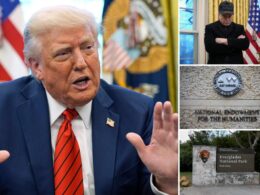WASHINGTON — Vice President JD Vance and Indian Prime Minister Narendra Modi said Monday they had agreed on a “roadmap” for negotiations over a trade deal to avert looming “reciprocal” tariffs — while President Trump insisted at the White House that talks with top US trading partners were going “very well.”
Little is publicly known about how negotiations with countries like Japan, South Korea, Australia, Vietnam and the United Kingdom are actually going — with a source close to the administration also telling The Post Monday that “the spin is out of control” and that this person “can’t tell what is cope and what is optimism.”
However, Trump officials have repeatedly insisted that a “tailor-made” deal with the New Delhi government is among the most likely to be reached, alongside agreements with Japan, South Korea and Vietnam.
Vance and Modi “welcomed significant progress in the negotiations for a U.S.-India Bilateral Trade Agreement (BTA) and formally announced the finalization of the Terms of Reference for the negotiations, laying down a roadmap for further discussions about our shared economic priorities,” according to a joint release.
“The BTA presents an opportunity to negotiate a new and modern trade agreement focused on promoting job creation and citizen well-being in both countries, with the goal of enhancing bilateral trade and supply-chain integration in a balanced and mutually beneficial manner.”
The statement added: “Guided by their respective visions of ‘Amrit Kaal for India’ and ‘Golden Age for America,’ BTA is expected to create new opportunities of growth for workers, farmers, and entrepreneurs in both countries.”
If talks are unsuccessful, India would face a tariff rate of 26% on imports beginning in early July.
A Japanese delegation left Washington Wednesday without announcing a final deal to avert that nation’s possible 24% rate — instead broadcasting plans for a second round of discussions later this month.
Trump told reporters at the White House Easter Egg Roll that he was confident that multiple deals would be reached.
“I think they’re going very well,” the president told reporters. “We’re going to make a lot of money. We’re already [levying] 25% on cars and aluminum and steel. Taking in a lot of money, more money than this country’s seen. And that’s just the beginning.”
The massive new duties took effect April 9 but were paused hours later to allow for 90 days of talks — with stated goals including eliminating foreign tariffs and non-tariff barriers, as well as evening out US trade deficits.
The president left in effect a new 10% baseline tariff on most imports, which could be removed in any one-for-one deal.








